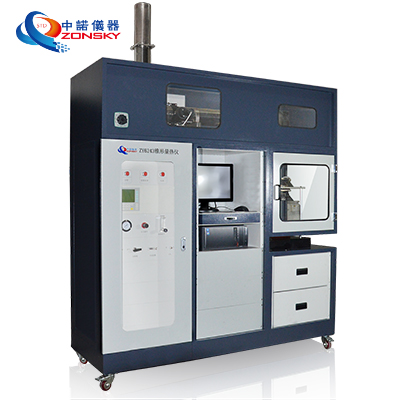
Hereinafter referred to as: thermal release rate
Parameter method:
Software operating system: it can collect and record total oxygen consumption, oxygen concentration, carbon dioxide concentration, temperature, heat release rate (HRR), total heat release (THR), effective heat of combustion (EHC), orifice flowmeter, thermocouple , C coefficient, flue gas flow rate, time to ignition(TTI), ignition time (temperature), rest time, critical ignition heat, thermal weight loss rate, nasty release rate, toxic gas generation rate, mass loss rate (MLR ) and other test data output, it can be saved and printed; it has powerful functions, especially for multi-curve comparison, which can intuitively compare the difference in burning characteristics of materials.
Gas analyzer: imported from Siemens, Germany. Oxygen (O2); T90 response time ≤3.5S; Dioxide (CO2), carbon monoxide (CO): T90 response time ≤3.5S. T90 response time is very important and directly determines the authenticity of the collected data.
Average Pyrolysis Rate and Radiant Energy
1. During the test, set different radiation energies after calibrating the Cone Calorimeter, and carry out 3 parallel tests under each radiation energy. The initial data of the sample
2. According to the principle of higher thermal release rate and shorter ignition time (the principle of the most dangerous fire), select a reasonable value as the actual application data, so that each material can be obtained.
3. Group data table 2 Raw data of samples under different radiation energy Sample 30kW/m, 2 mass/g thickness/mm40kW/m mass/g thickness/mm50kW/m mass/g thickness/mm white plexiglass 291.6 25 300.6 25 304.5 25 cypress 97.4 25 94.8 25 88.4 25 rosewood 138.9 25 136.8 25 140.3 25 The thermal release rate is one of the most important fire behavior parameters of the material, which is defined as fire intensity. The more heat, the faster the thermal cracking rate of the material, so more volatile combustibles are produced, and the flame propagation is correspondingly accelerated, and the greater the fire risk after all. Therefore, the average thermal release rate of the material is used. The study was conducted as a primary consideration policy, as shown in 3. The average thermal release rate of the samples at different radiant energies kW/m Sample 30 40 50 white plexiglass 399 506 604 cypress 41 55 72 fragrant rosewood 33 53 61 basis, white The three sets of data of plexiglass are plotted with the radiation energy as the abscissa and the average thermal release rate as the ordinate, and an approximate straight line is obtained. Equation system: (3x120/120x5000)・m/n=150962410, the solution is: m=93,n=10.25, so y=93+10.25x. Similarly, the equation system of Cypress: (3x120/120x5000)・m/ n=1687030, the solution is: m=-6.n=1.55, so y=-6+1.55x. The equation system of Hongmu is: (3x120/120x5000)・m/n=1476160, the solution is: m=-7 , n=1.4, so y=-7+1.4x. It can be seen that for the same material with the same thickness and slightly different quality (generally speaking, the quality difference in this case will not be too large), the thermal release rate It is approximately a straight line with the radiant energy, most of the data can be in excellent agreement with the straight line, and the deviation is very small. The slope of this function, the greater the slope of the function, the more this line tends to the y-axis, the faster the heat release rate increases with the radiant energy, the more heat is released. Therefore, this coefficient can be used to evaluate the data The explosive power of the material can be seen from it, and the potential of the material incineration can be seen from it, so the author calls it the "thermal release coefficient" of the material, that is to say, the larger the coefficient, the more the thermal release rate increases under the condition of increasing the same radiant energy, and the release rate increases. The more heat there is. The materials are not the same, the thermal release coefficient is different, and the thermal release coefficient of wood is between 1 and 2. This thermal release is related to the function of the material itself. In the future research work, it can be further passed. Many experiments are required to obtain the thermal release coefficient of various materials. Only the "thermal release coefficient" of each material and a certain radiation The thermal release rate under radiant energy can be inferred, and the thermal release rate of materials under other radiant energies can be inferred. And the thermal release coefficient can directly distinguish the difficulty of material incineration.
 WhatsApp:
WhatsApp: Mobile Phone:
Mobile Phone: Contact Now
Contact Now